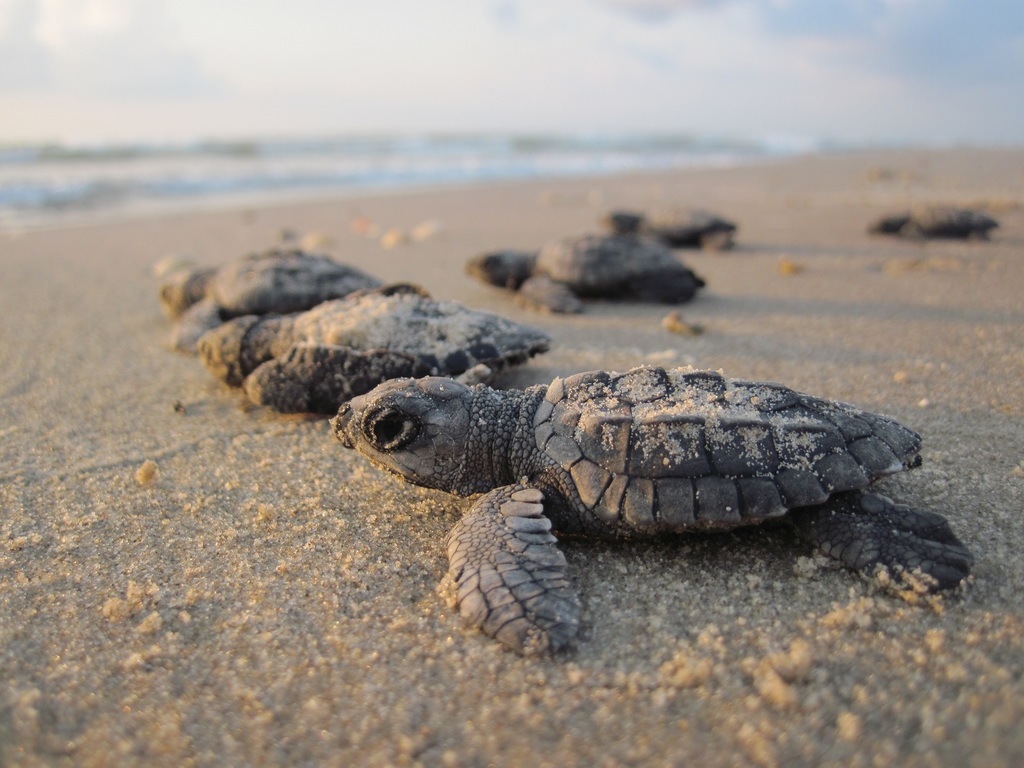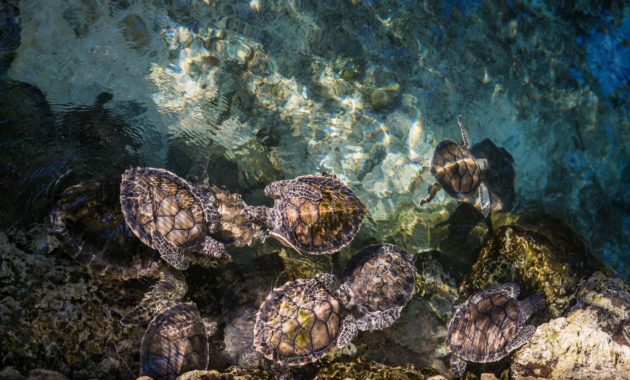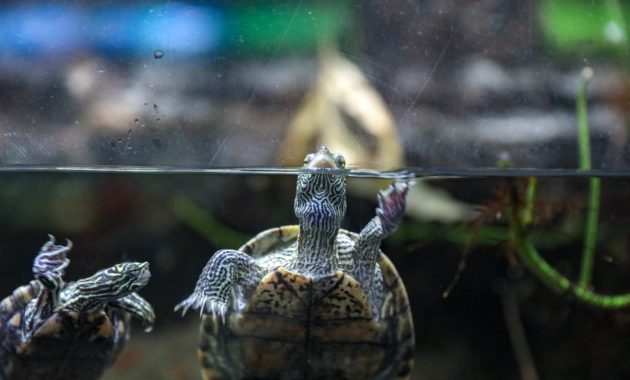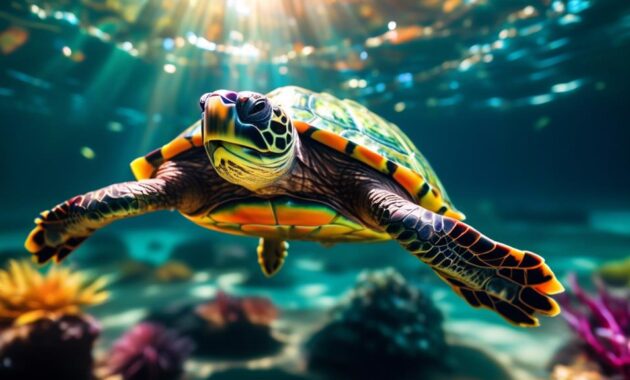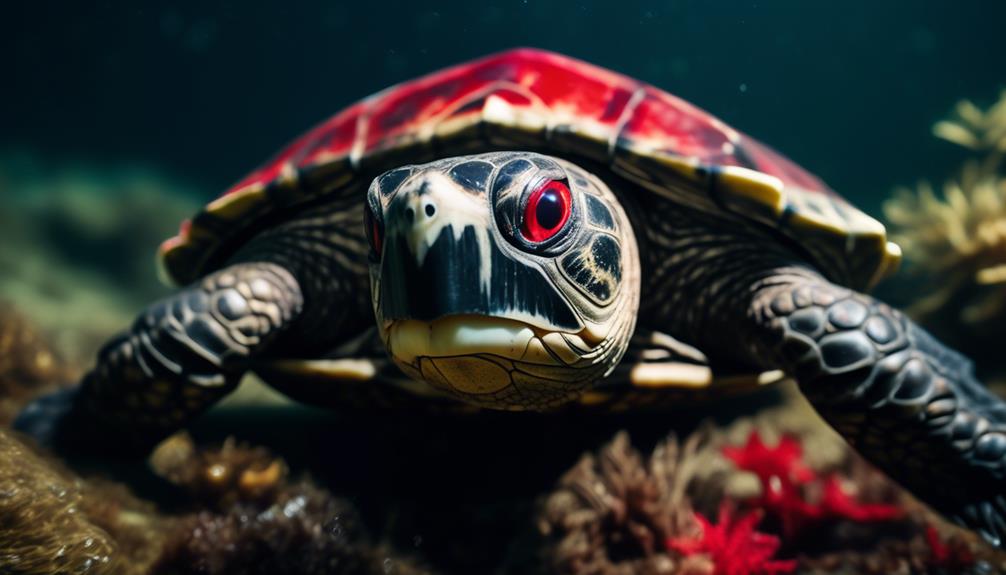
As the saying goes, ‘Don’t judge a book by its cover,’ the same can be said for the foul-smelling Stinkpot Turtle. This unassuming creature may not seem intriguing at first glance, but beneath its unimpressive exterior lies a world of captivating behaviors and characteristics.
From its unique defensive mechanism to its distinct physical features, the Stinkpot Turtle is a creature that demands further investigation. So, prepare to be surprised as we uncover the secrets of this fascinating aquatic creature and explore its diet, care requirements, and more.
Key Takeaways
- The Common Musk Turtle, also known as the Stinkpot Turtle, is a small aquatic turtle found in the eastern parts of North America.
- It emits a foul odor as a defense mechanism, hence its nickname.
- The turtle has a lifespan of 30-50 years and can be kept in a tank with a minimum size of 20 gallons for one turtle or 40 gallons for a pair.
- It requires a varied diet including pelleted commercial food, insects, snails, mollusks, worms, fish, and non-toxic aquatic plants.
General Information
The Common Musk Turtle, also known as the Stinkpot Turtle, emits a foul odor as a defense mechanism. This small aquatic turtle can vary in size and has a lifespan of 30-50 years. It’s native to the eastern parts of North America and can be found in river habitats, slow-flowing portions of streams, ponds, and lakes.
The Stinkpot Turtle has a blackish-brown carapace that’s highly domed with a vertebral keel. As it ages, the yellow stripes on its head may fade.
In terms of diet and care requirements, it can be fed a varied diet consisting of pelleted commercial diet, insects, snails, mollusks, worms, fish, and non-toxic aquatic plants. The turtle should be housed in a tank with a bare bottom or medium-sized gravel, with a minimum tank size of 20 gallons for one turtle and 40 gallons for a pair. It’s important to provide a submersible canister water filter and non-chlorinated water deep enough for the hind legs to touch the bottom. Additionally, a floating dock or basking area with a basking light should be provided.
When handling the Stinkpot Turtle, it’s crucial to be gentle to avoid triggering its defense mechanism. The offensive odor and bites can be minimized by handling the turtle from the rear, and it’s best to introduce captive-bred turtles for familiarity with handling.
When housing multiple turtles, it’s recommended to have one female and one male, as keeping two males together may lead to harassment.
Size and Appearance
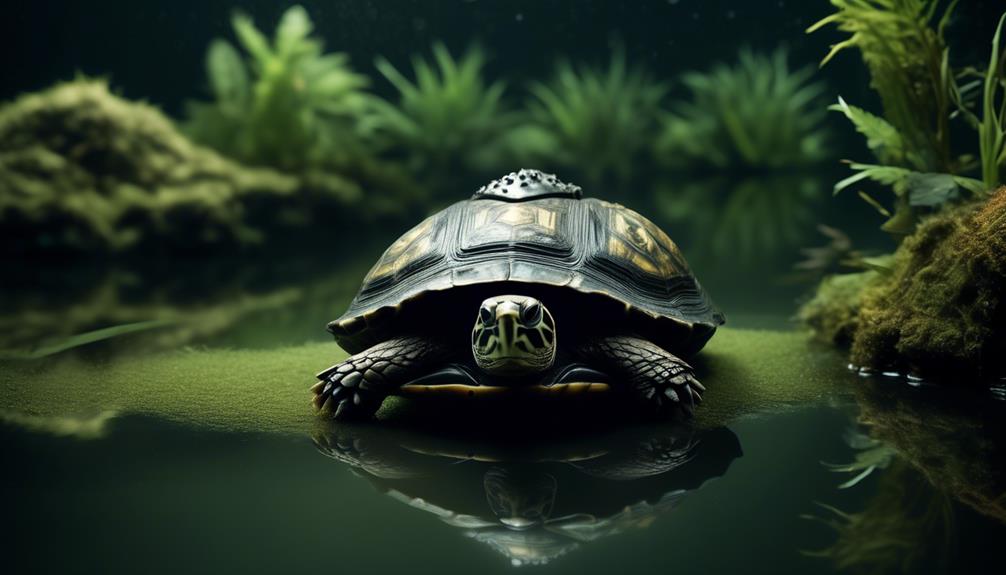
Want to know more about the size and appearance of the Stinkpot Turtle?
These fascinating aquatic creatures are relatively small in size, with their length varying. They’re commonly known as the Common Musk Turtle and have a highly domed, blackish-brown carapace with a vertebral keel.
As they age, the yellow stripes on their head tend to fade.
Native to the eastern parts of North America, Stinkpot Turtles can be found in river habitats, slow-flowing portions of streams, ponds, and lakes.
Their unique appearance and foul odor, emitted as a defense mechanism, make them truly intriguing creatures to observe.
Native Habitat
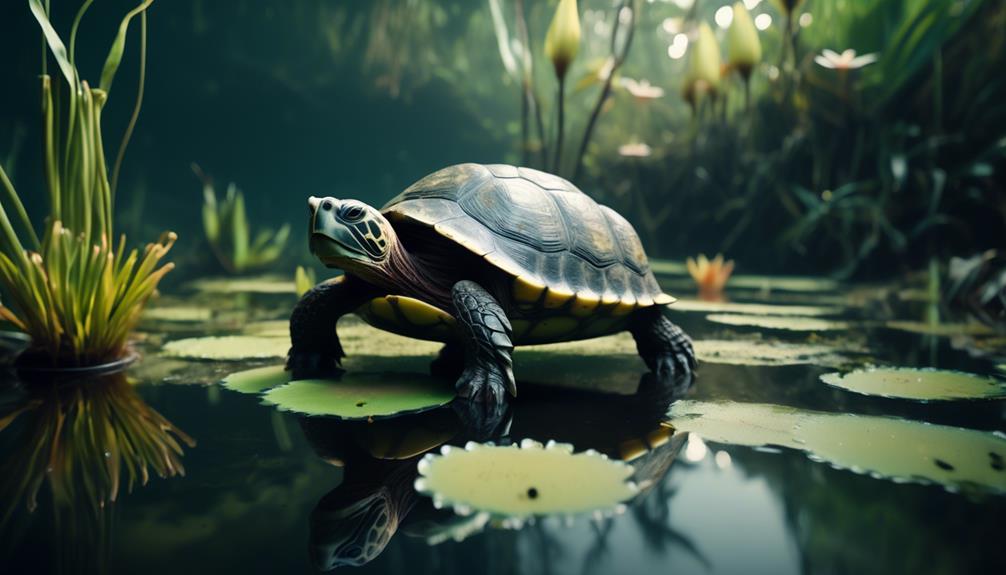
Stinkpot Turtles can be found in the eastern parts of North America, inhabiting river habitats, slow-flowing portions of streams, ponds, and lakes. They have adapted to these aquatic environments, where they can find ample food sources and suitable nesting areas. The table below provides a summary of their native habitat:
| Native Habitat of Stinkpot Turtles |
|---|
| River Habitats |
| Slow-flowing Portions of Streams |
| Ponds |
| Lakes |
These turtles are well-suited to these habitats, as they are excellent swimmers and can navigate through the water with ease. They are often found near submerged vegetation and underwater debris, which provide them with shelter and protection. The eastern parts of North America offer the ideal conditions for Stinkpot Turtles to thrive, ensuring their continued presence in these diverse aquatic ecosystems.
Diet and Feeding Requirements
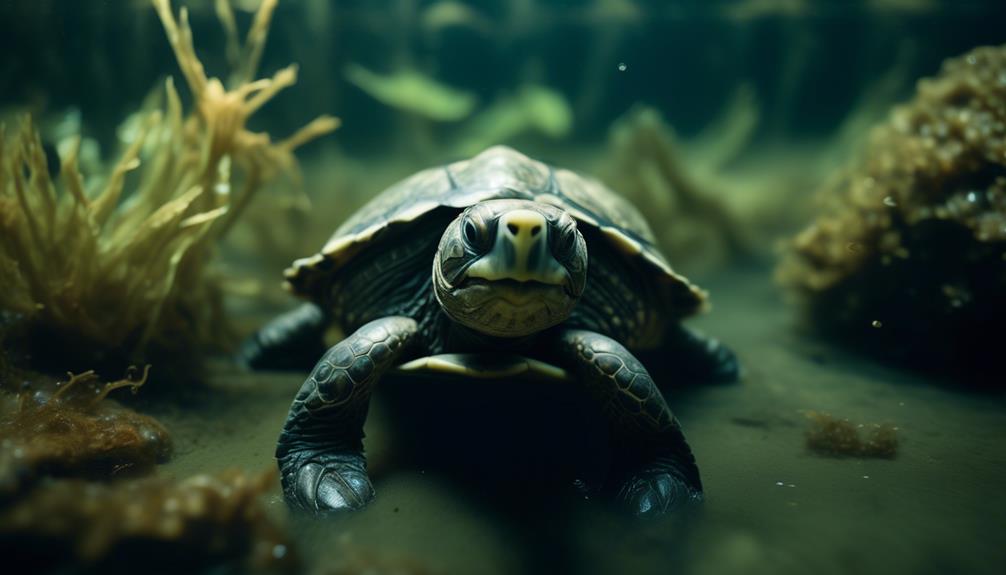
After exploring the native habitat of Stinkpot Turtles in the eastern parts of North America, it’s important to understand their unique diet and feeding requirements. These fascinating aquatic creatures have a varied diet consisting of pelleted commercial diet, insects, snails, mollusks, worms, fish, and non-toxic aquatic plants. They also consume a range of specific foods such as mollusks, snails, crayfish, small tadpoles, aquatic and terrestrial insects, plants, fish, shrimp, earthworms, bloodworms, and crickets.
It’s recommended to provide them with a tank with a bare bottom or medium-sized gravel, a minimum of 20 gallons for one turtle and 40 gallons for a pair. Non-chlorinated water, deep enough for their hind legs to touch the bottom, and a floating dock or basking area with a basking light should also be provided.
Handle them with care to avoid offensive odor and bites, and it’s best to introduce captive-bred turtles for familiarity with handling.
Tank Setup and Care
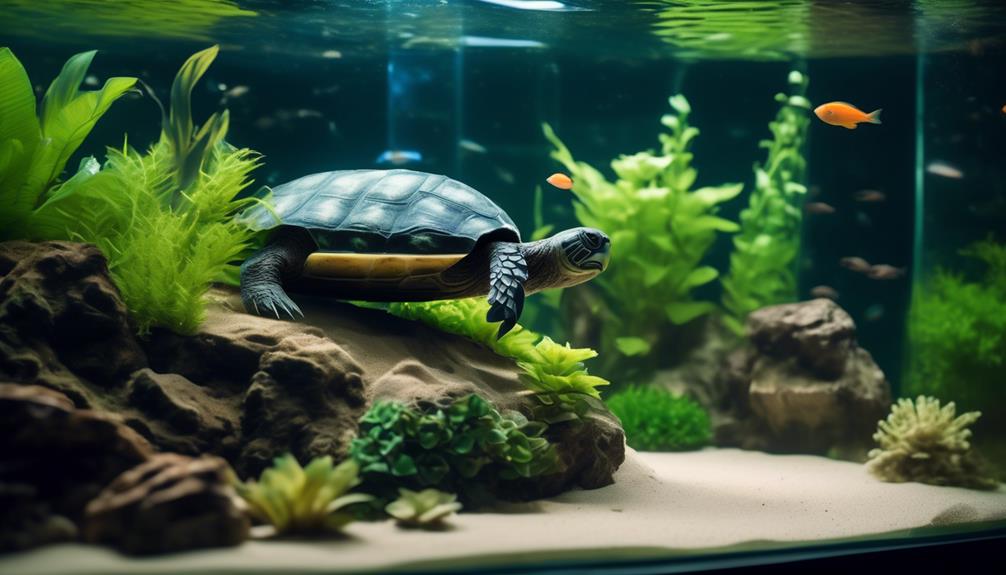
To ensure proper tank setup and care for your Stinkpot Turtle, it’s important to provide a suitable environment that meets their specific needs. The tank should have a bare bottom or optional medium-sized gravel.
For one turtle, a minimum tank size of 20 gallons is required, while a pair of turtles would need a minimum tank size of 40 gallons.
Use a submersible canister water filter to keep the water clean and non-chlorinated. The water level should be deep enough for the turtle’s hind legs to touch the bottom.
Additionally, provide a floating dock or basking area with a basking light for the turtle to climb onto.
It’s essential to handle the turtle with care to avoid offensive odor and bites. It’s also recommended to introduce captive-bred turtles for familiarity with handling and to avoid keeping two males together.
Handling and Odor Control
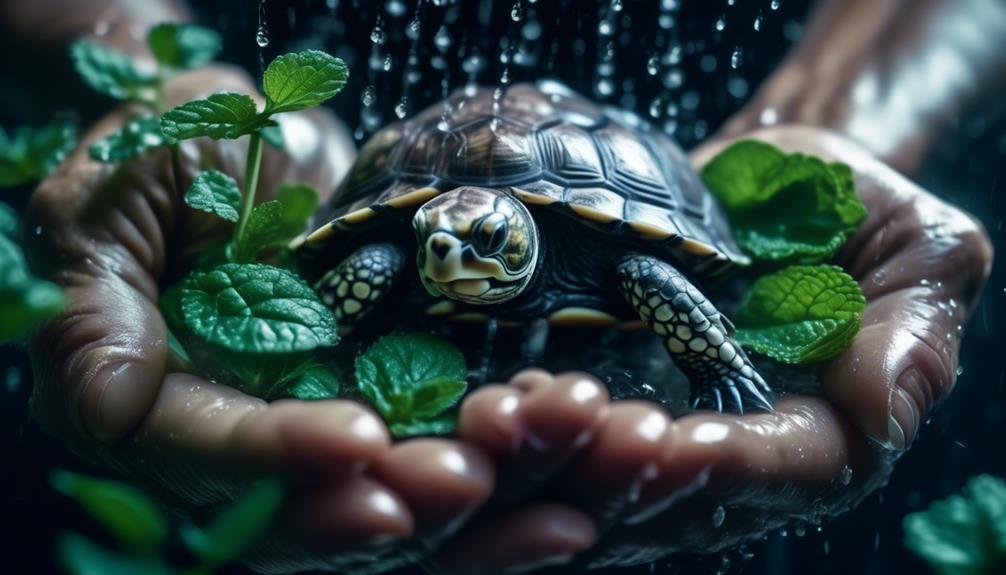
When handling a Stinkpot Turtle, it’s important to approach with caution to avoid triggering its defensive odor. These turtles have a unique defense mechanism where they emit a foul-smelling liquid from glands near their tail. To prevent this from happening, it’s best to handle them with care and avoid frightening them.
Keep your fingers towards the rear of the turtle to reduce the risk of being bitten. If you have a male and female turtle together and notice any harassment, it’s recommended to separate them.
It’s also worth noting that captive-bred turtles may be less frightened of people and more accustomed to handling. So, if you’re new to handling Stinkpot Turtles, it may be beneficial to start with captive-bred ones.
Behavior and Socialization
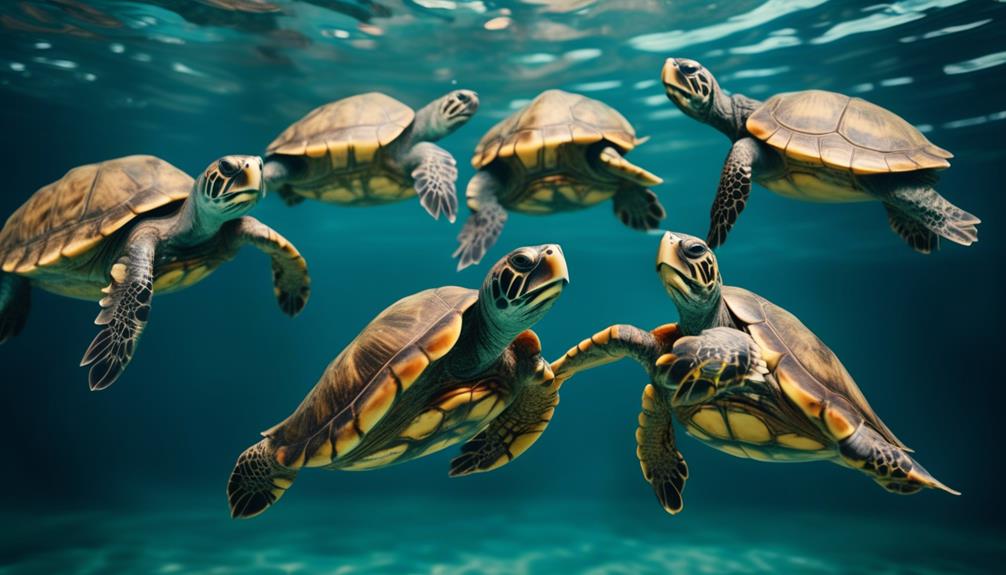
Stinkpot Turtles exhibit fascinating behavior and socialization patterns, making them intriguing aquatic turtles to observe and understand. These turtles have a unique defense mechanism where they emit offensive liquid and odor when they feel threatened. It’s important to handle them with care to avoid frightening them and to reduce the risk of getting bitten. If harassment occurs between a male and a female turtle, it’s recommended to separate them.
Captive-bred turtles may be less frightened of people and more accustomed to handling. In terms of socialization, it’s best to pair a male and a female turtle, as keeping two males together can lead to aggression. By studying their behavior and social interactions, we can gain a deeper understanding of these fascinating creatures.
Tank Environment and Filtration
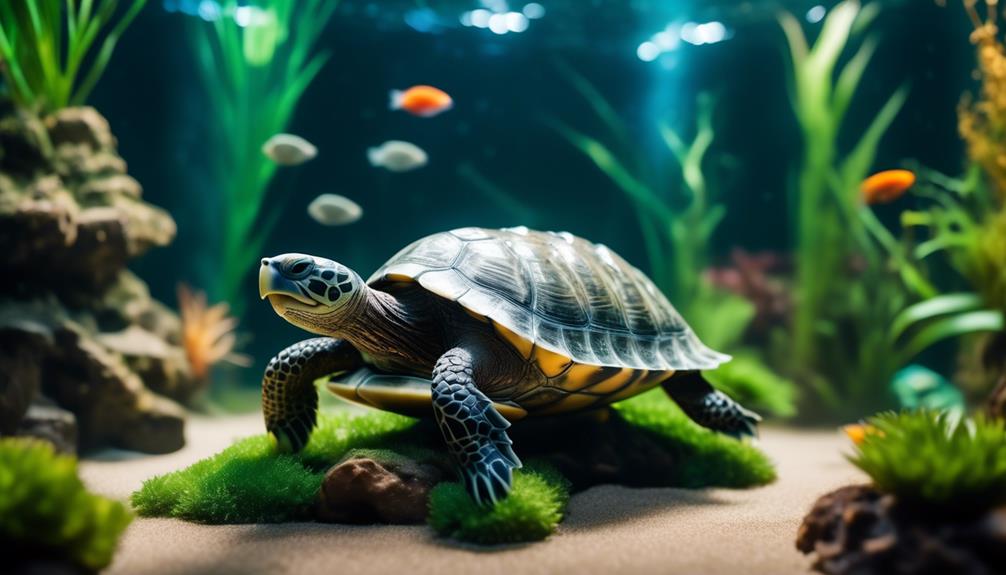
Creating an appropriate tank environment and ensuring proper filtration are essential for the well-being of your stinkpot turtle.
To start, choose a tank with a bare bottom or medium-sized gravel. For one turtle, a minimum tank size of 20 gallons is recommended, while a pair will require a minimum of 40 gallons.
Invest in a submersible canister water filter to maintain water quality. Make sure to use non-chlorinated water, deep enough for your turtle’s hind legs to touch the bottom.
Additionally, provide a floating dock or basking area with a basking light for your turtle to rest and thermoregulate.
Remember to handle your stinkpot turtle with care to avoid its offensive odor and bites.
Lifespan and Natural Habitat
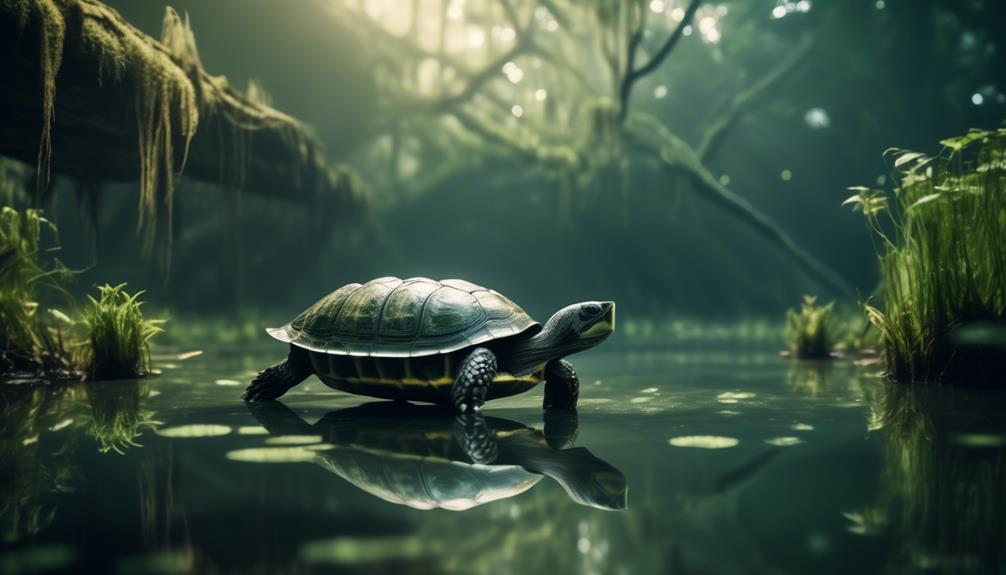
To properly understand the lifespan and natural habitat of the stinkpot turtle, it’s important to explore its native environment and the factors that contribute to its longevity.
Stinkpot turtles, also known as common musk turtles, can live for 30 to 50 years. These small aquatic turtles are native to the eastern parts of North America. They can be found in river habitats, slow-flowing portions of streams, ponds, and lakes.
The stinkpot turtle has a blackish-brown carapace that’s highly domed with a vertebral keel. As they age, the yellow stripes on their head may fade.
Stinkpot turtles have a varied diet, including pelleted commercial diet, insects, snails, mollusks, worms, fish, and non-toxic aquatic plants. They require a tank with non-chlorinated water that’s deep enough for their hind legs to touch the bottom, as well as a floating dock or basking area with a basking light.
Handling them with care is important to avoid their offensive odor and bites. It’s best to introduce captive-bred turtles for familiarity with handling, and avoid keeping two males together.
Breeding and Pairing
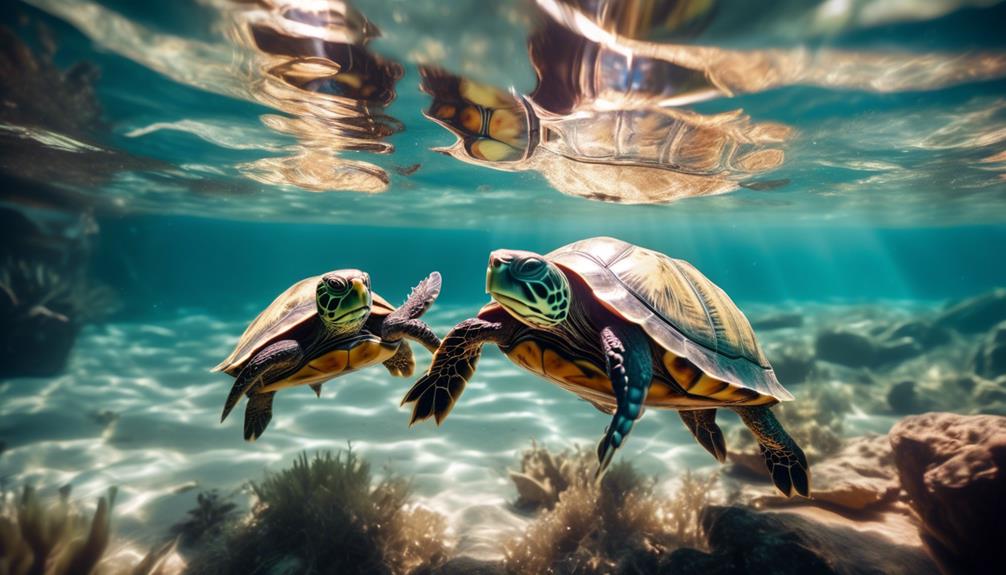
When breeding and pairing stinkpot turtles, it’s important to consider their specific care requirements and behaviors. Stinkpot turtles should be kept in a tank with a bare bottom or medium-sized gravel. The tank should be a minimum of 20 gallons for one turtle and 40 gallons for a pair. A submersible canister water filter is necessary to maintain water quality. The water should be non-chlorinated and deep enough for the turtle’s hind legs to touch the bottom.
It’s also crucial to provide a floating dock or basking area with a basking light. When handling stinkpot turtles, it’s important to be cautious as they emit offensive liquid and odor as a defense mechanism. It’s best to handle them towards the rear to reduce the risk of biting.
It’s advisable to pair one female and one male together and avoid keeping two males together to prevent harassment.
Tips for Keeping Stinkpot Turtles
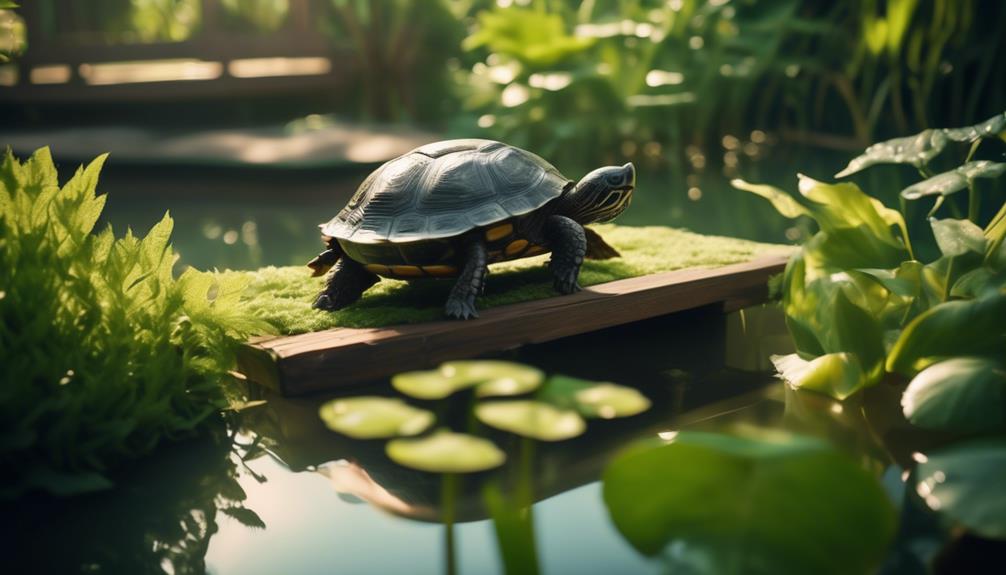
Looking to keep stinkpot turtles? Here are some helpful tips to ensure their well-being and happiness in your care.
| Tips for Keeping Stinkpot Turtles |
|---|
| – Provide a tank size of at least 20 gallons for one turtle, or 40 gallons for a pair. |
| – Use a submersible canister water filter to keep the water clean. |
| – Use non-chlorinated water that is deep enough for the turtle’s hind legs to touch the bottom. |
| – Create a floating dock or basking area with a basking light for the turtle to dry off and bask. |
| – Feed them a varied diet including pelleted commercial diet, insects, snails, mollusks, worms, fish, and non-toxic aquatic plants. |
Frequently Asked Questions
How Can I Prevent My Stinkpot Turtle From Emitting a Foul Odor?
To prevent your stinkpot turtle from emitting a foul odor, handle it with care to avoid frightening it. Keep your fingers towards the rear to reduce the risk of biting.
Are Stinkpot Turtles Aggressive Towards Other Turtle Species?
Stinkpot turtles can be aggressive towards other turtle species, especially if they feel threatened or their territory is invaded. It is best to keep them separate to prevent any conflicts or harm.
Can Stinkpot Turtles Be Housed With Other Aquatic Pets, Such as Fish or Snails?
Yes, stinkpot turtles can be housed with other aquatic pets like fish or snails. However, be cautious as stinkpot turtles may eat smaller tank mates and produce foul odor. Ensure proper care and monitoring.
What Is the Ideal Water Temperature for Stinkpot Turtles?
The ideal water temperature for stinkpot turtles is between 75-80 degrees Fahrenheit. It’s important to maintain a consistent temperature to ensure their well-being. Use a reliable thermometer and adjust the heating equipment accordingly.
Can Stinkpot Turtles Be Trained to Recognize Their Owners?
No, stinkpot turtles cannot be trained to recognize their owners. They do not possess the cognitive abilities for such recognition. These turtles rely on their instincts and natural behaviors in their interactions with humans.
What Makes the European Pond Turtle Different from the Foul-Smelling Stinkpot Turtle?
The fascinating European pond turtle can be distinguished from the foul-smelling stinkpot turtle by its distinct physical features and habitat preferences. The European pond turtle is known for its bright yellow and green markings and is commonly found in freshwater ponds and lakes throughout Europe.
Conclusion
In conclusion, the foul-smelling Stinkpot Turtle is a fascinating aquatic creature with unique characteristics and behaviors. From their defensive odor to their distinctive appearance, these turtles are truly captivating.
Understanding their diet and care requirements, as well as providing a suitable tank setup, is essential for their well-being. By following these tips and handling them with care, you can enjoy the company of these intriguing turtles for many years to come.

